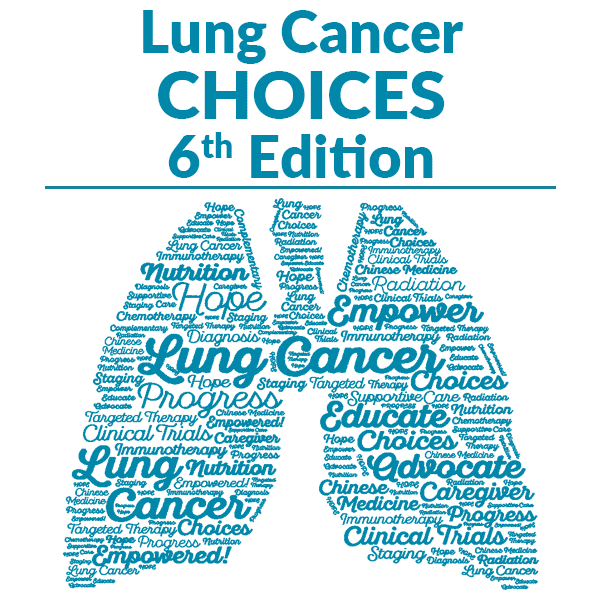Lung Cancer Choices© 6th Edition Menu
Chapter 1: Diagnosis and Staging of Lung Cancer
Chapter 2: Comprehensive Biomarker Testing
Chapter 3: Surgery for Lung Cancer Patients
Chapter 5: Radiation Therapy for Non-Small Cell Lung Cancer
Chapter 6: Treatment for Small Cell Lung Cancer
Chapter 7: Clinical Trials and Emerging Therapies for Lung Cancer
Chapter 9: Nutrition in the Patient with Lung Cancer
Chapter 10: Sexuality and Lung Cancer
Chapter 11: Integrative Medicine, Complementary Therapies, and Chinese Medicine in Lung Cancer
Chapter 12: Lung Cancer in People who have Never Smoked
Chapter 13: How to Quit Smoking Confidently and Successfully
Lung Cancer Question Builder - Develop your list of "Questions to Ask" your providers
Supportive Care
Christie Lynn Pratt, MA, DHSc
Introduction
Advances in early detection and the development of new treatment options such as targeted combination therapies and immunotherapies have increased survival rates for lung cancer patients over the last decade. However, many of these advances have associated known side effects that can present during the course of the disease and even after active treatment. It is important to address the longitudinal effects of treatment and recognize the need for and value of early supportive care interventions for patients. Many treatment options available in standard care or clinical trials are accompanied by known side effects. Advances in supportive care have changed the cancer experience for many patients. Supportive care is a valuable part of the success of treatment and helps to provide positive outcomes. As a result, practitioners are better prepared to address and prevent cancer-related symptoms.
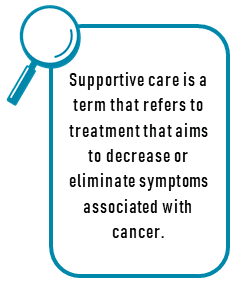 Supportive care is a term that refers to treatment that aims to decrease or eliminate symptoms associated with cancer. The goal is to maximize comfort, minimize suffering, and ensure the highest quality of life. Supportive care focuses on treating the cancer-related symptoms, preventing and managing treatment-related side effects, recognizing and supporting psychosocial distress, and helping to develop strategies for improving quality of life.1 Comprehensive supportive care may address symptoms that occur at diagnosis and during or after treatment.
Supportive care is a term that refers to treatment that aims to decrease or eliminate symptoms associated with cancer. The goal is to maximize comfort, minimize suffering, and ensure the highest quality of life. Supportive care focuses on treating the cancer-related symptoms, preventing and managing treatment-related side effects, recognizing and supporting psychosocial distress, and helping to develop strategies for improving quality of life.1 Comprehensive supportive care may address symptoms that occur at diagnosis and during or after treatment.
Being diagnosed with lung cancer is a life-changing event that can have a profound effect on the physical, emotional, and psychosocial aspects of one’s well-being. There are many symptoms and side effects associated with lung cancer diagnosis and treatment. These symptoms can interfere with the ability to function and perform daily activities, decreasing the patient’s quality of life, especially if symptoms are ignored and go untreated. Lung cancer patients have more unmet supportive care needs than patients with other cancers. Lung cancer is often associated with a heavy disease burden, and patients can derive benefit from supportive care interventions, thus limiting impact. A high symptom burden can have a direct negative impact on one’s quality of life. The American Society of Clinical Oncology (ASCO) and the National Comprehensive Cancer Network (NCCN)’s clinical practice guidelines recommend implementing supportive care interventions early in routine oncology care.2 Supportive care interventions can improve well-being and survival for cancer patients.3 Intervening early may decrease unnecessary suffering and enable patients to feel strong enough to be active participants in their cancer care. The goal of supportive care is to provide patients with the best quality of life throughout the cancer experience, enabling them to perform daily activities and engage in activities that bring them joy and happiness.
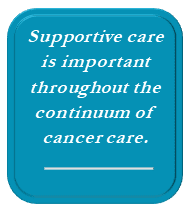 Supportive care is important throughout the continuum of cancer care. Supportive care needs may change during the course of the disease and assessment, including diagnosis, treatment, survivorship, and end of life.4 People living with cancer may experience varied symptoms during the course of the disease, such as more psychological concerns and symptoms at the time of diagnosis than at later stages of treatment.5 However, physical symptoms may become an immediate concern during treatment.6 As the disease and physical symptoms progress, patients may experience difficulties in coping with the situation.2 Patients with advanced cancer or disease progression must address a change or deterioration of physical health, resulting in psychological and social concerns.5 The management of these symptoms and psychological distress is important to optimize quality of life.
Supportive care is important throughout the continuum of cancer care. Supportive care needs may change during the course of the disease and assessment, including diagnosis, treatment, survivorship, and end of life.4 People living with cancer may experience varied symptoms during the course of the disease, such as more psychological concerns and symptoms at the time of diagnosis than at later stages of treatment.5 However, physical symptoms may become an immediate concern during treatment.6 As the disease and physical symptoms progress, patients may experience difficulties in coping with the situation.2 Patients with advanced cancer or disease progression must address a change or deterioration of physical health, resulting in psychological and social concerns.5 The management of these symptoms and psychological distress is important to optimize quality of life.
Symptom Management
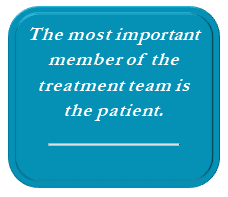 Interdisciplinary healthcare teams provide comprehensive assessment and consultation for lung cancer patients. The teams are integral to ensure a holistic treatment approach, treating the whole person and not just cancer itself. The primary treatment team includes a physician (medical oncologist, radiation oncologist, or thoracic surgeon, depending on the course of treatment), advanced practice professional (physician assistant or nurse practitioner), and a primary nurse or nurse navigator. As supportive care needs emerge, a patient may be referred to additional members of the healthcare team, such as social workers, behavioral medicine professionals like psychiatrists or psychologists, palliative care/supportive care clinicians, dietitians or physical therapists, to make further assessments and supportive care recommendations. The most important member of the treatment team is the patient. Many of the symptoms and side effects associated with lung cancer diagnosis are individual and require self-reporting and monitoring. Open communication with the clinical team about any symptoms or side effects makes the patient a partner in the care and helps the healthcare team understand and recognize the onset of side effects. A comprehensive supportive care plan with the healthcare team enables the highest possible mental, emotional, and physical well-being. The goal includes controlling symptoms related to lung cancer and treatment, and concurrently providing psychosocial care to improve quality of life. Most symptoms can be effectively controlled, and managed, and new supportive care treatments and therapies are continuing to evolve.
Interdisciplinary healthcare teams provide comprehensive assessment and consultation for lung cancer patients. The teams are integral to ensure a holistic treatment approach, treating the whole person and not just cancer itself. The primary treatment team includes a physician (medical oncologist, radiation oncologist, or thoracic surgeon, depending on the course of treatment), advanced practice professional (physician assistant or nurse practitioner), and a primary nurse or nurse navigator. As supportive care needs emerge, a patient may be referred to additional members of the healthcare team, such as social workers, behavioral medicine professionals like psychiatrists or psychologists, palliative care/supportive care clinicians, dietitians or physical therapists, to make further assessments and supportive care recommendations. The most important member of the treatment team is the patient. Many of the symptoms and side effects associated with lung cancer diagnosis are individual and require self-reporting and monitoring. Open communication with the clinical team about any symptoms or side effects makes the patient a partner in the care and helps the healthcare team understand and recognize the onset of side effects. A comprehensive supportive care plan with the healthcare team enables the highest possible mental, emotional, and physical well-being. The goal includes controlling symptoms related to lung cancer and treatment, and concurrently providing psychosocial care to improve quality of life. Most symptoms can be effectively controlled, and managed, and new supportive care treatments and therapies are continuing to evolve.
There can be side effects associated with lung cancer and treatment. Symptoms and side effects vary between patients and treatments during the course of the disease. Some side effects are well documented and associated with common therapies but with newer treatments or those being researched in the setting of clinical trials not all side effects are known. Effectively communicating any changes experienced can prevent unnecessary suffering or interruption of treatment. With the growing research and knowledge of these side effects, medications and self-help strategies can be recommended to help prevent symptoms before they occur. However, if new symptoms arise, effective treatments can be prescribed to help control them. It is important to know that symptoms can be managed successfully if they are addressed and treated early.
Patients, caregivers, and members of the healthcare team should openly and honestly discuss expectations before the start of each new therapy. Having an open dialogue about treatment goals and an understanding about the potential side effects can ease distress and anxiety. Patients should ask questions and gather as much information as possible to help them assess whether the benefits of the treatment options outweigh the potential effect on their quality of life.
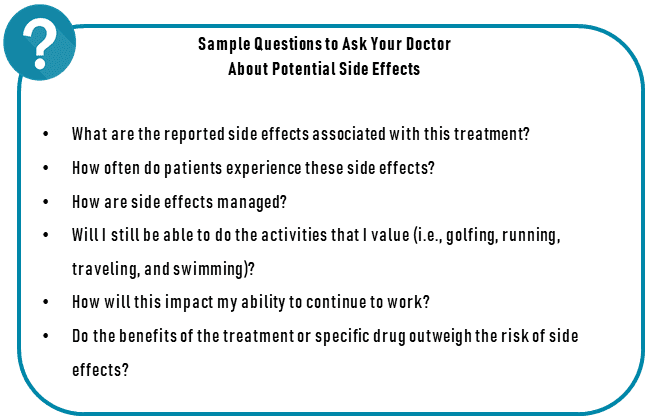
Asking these questions can help in the decision about treatment and better prepare the patient to recognize and handle when side effects occur. While the side effect profiles for the standard of care treatment regimens are well documented, the side effect profiles for clinical research trials may be less known, and depending on the phase of the trial, side effects may be unknown. When participating in a clinical trial, it is of great importance to learn about the side effects that previous patients have experienced while on the experimental regimen. It is also important to also accurately document and report any side effects you may experience while on a trial. Preparing for making a treatment decision is an important time for patients to relay their value system to the healthcare team. Some patients value their physical appearance, and the loss of hair during treatment would have a major negative effect on their self-image and social activity level. If hair loss is important to you, the clinician may be able to discuss some treatment options with minimal or no hair loss.
Communicating Symptoms
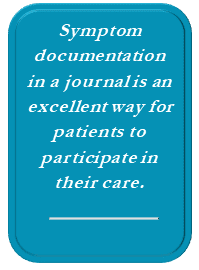 Communication is a vital part of symptom management. Symptom documentation in a journal is an excellent way for patients to participate in their care and should be an integral part of the cancer experience. Documenting the onset of new symptoms and being able to communicate this information effectively can have a major effect on the success of treatment (Figure 1). Daily symptom tracking, especially while receiving treatment, helps patients identify any changes in their physical, psychological, and emotional health. Maintaining this crucial information can help assess and manage the supportive care needs of the patient. The ability to reference and chart the progress of specific issues enables the patient to have an open dialogue with the team. Furthermore, keeping a journal is important in self-help strategies. When managing fatigue, a patient can refer to the journal and identify periods during the day of both high and low energy, and then try to accomplish essential tasks during periods of high energy.
Communication is a vital part of symptom management. Symptom documentation in a journal is an excellent way for patients to participate in their care and should be an integral part of the cancer experience. Documenting the onset of new symptoms and being able to communicate this information effectively can have a major effect on the success of treatment (Figure 1). Daily symptom tracking, especially while receiving treatment, helps patients identify any changes in their physical, psychological, and emotional health. Maintaining this crucial information can help assess and manage the supportive care needs of the patient. The ability to reference and chart the progress of specific issues enables the patient to have an open dialogue with the team. Furthermore, keeping a journal is important in self-help strategies. When managing fatigue, a patient can refer to the journal and identify periods during the day of both high and low energy, and then try to accomplish essential tasks during periods of high energy.
In this chapter, we focus on the physical and psychosocial symptoms associated with lung cancer and identify supportive care strategies to improve quality of life. Information provided can help patients be aware of potential symptoms and recognize the early onset of symptoms. Patients can better tolerate treatment by working quickly to address any symptoms. The goal is open communication about any symptoms or changes in function to ensure the best quality of life and active participation in decisions during and after treatment.
Figure 1. My Symptom Management Journal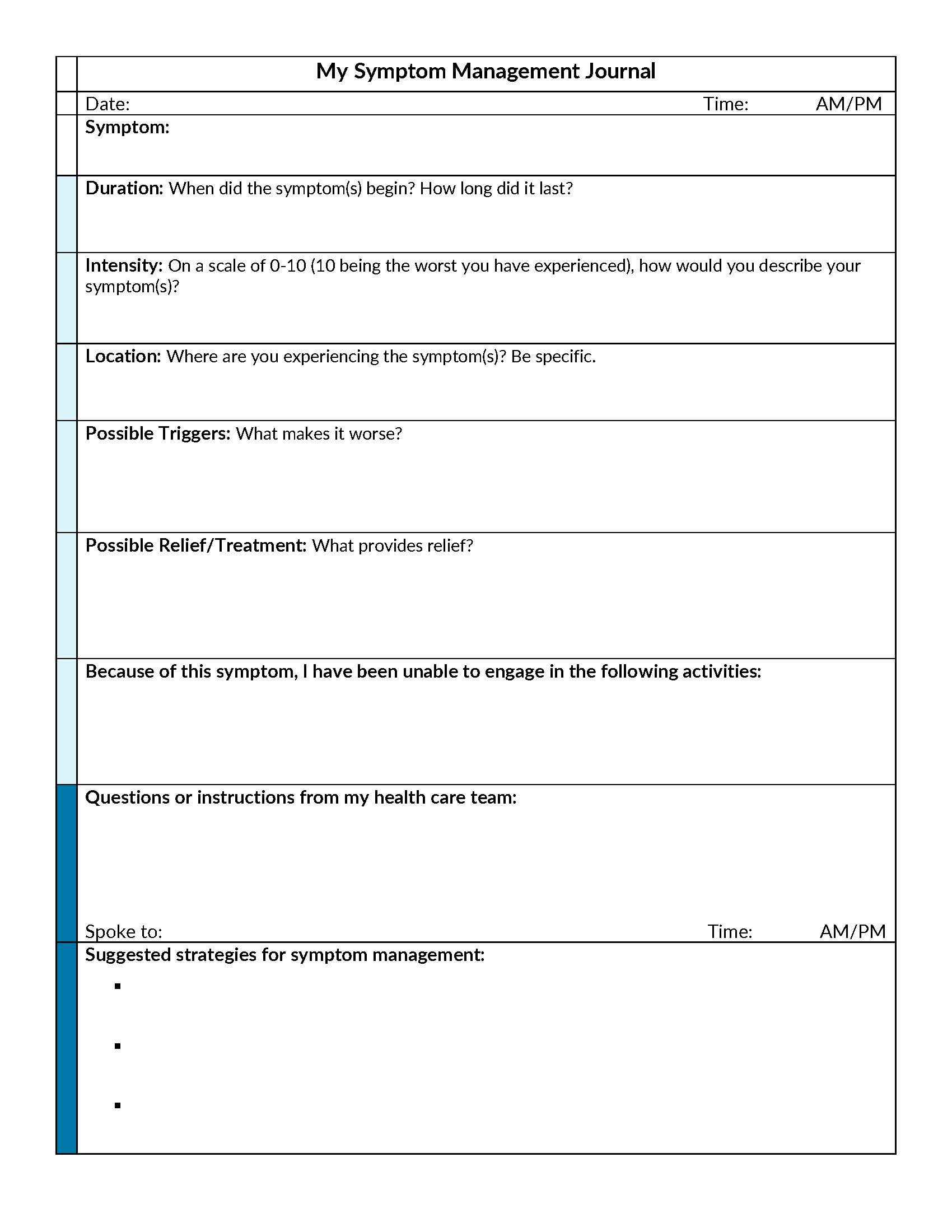 Click here for the My Symptom Management Journal Form
Click here for the My Symptom Management Journal Form
The Changing Role of Palliative and Supportive Care Services
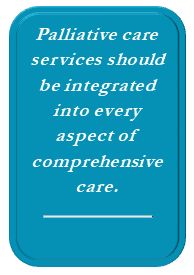 The word palliative means to relieve from suffering. The field of palliative care had previously focused on care related to end of life. There has been an increased understanding of the importance of palliative care services being integrated into all aspects of cancer care. There has been a new focus on the value of services being provided through diagnosis, treatment, survivorship, and later increased levels of needs at the end of life. Palliative care services should be integrated into every aspect of comprehensive care.
The word palliative means to relieve from suffering. The field of palliative care had previously focused on care related to end of life. There has been an increased understanding of the importance of palliative care services being integrated into all aspects of cancer care. There has been a new focus on the value of services being provided through diagnosis, treatment, survivorship, and later increased levels of needs at the end of life. Palliative care services should be integrated into every aspect of comprehensive care.
Palliative care focuses on the management of pain and other distressing symptoms. The goal is to prevent and relieve symptoms to support quality of life. Services can be delivered concurrently with life-prolonging treatments, not just end of life care. For advanced-stage lung cancer patients, early palliative care can cause major improvements in quality of life, decreased psychological symptoms, and survival benefits.7-8 There is important value to providing palliative care throughout the continuum of care.
Physical Symptoms Associated with Lung Cancer
Fatigue
Fatigue is among the most common problems experienced by patients, occurring in approximately 90% of patients receiving treatment.9-10 Fatigue is disruptive and debilitating because it affects all aspects of life. Some patients report that fatigue is worse than nausea or pain that can be controlled with medications.9 Persistent fatigue can negatively affect quality of life because patients may have less energy to perform typical daily activities and activities they value.
Causes and Assessment
Fatigue is the overall feeling of being tired physically, mentally, and emotionally.9 Patients may describe fatigue as general weakness, persistent lack of energy, exhaustion, lack of motivation, and inability to concentrate. Contributing factors to fatigue include pain, anemia, psychological distress, sleep disturbance, nutritional deficiency, prescription medications, and cancer treatment. Chemotherapy agents may cause changes in blood count levels. Platinum-based chemotherapy agents, taxanes, and pemetrexed may cause anemia and fatigue symptoms in lung cancer patients.5, 11-12 Fatigue can also linger for multiple years after cancer treatment has been completed.12 A change in breathing capacity may cause fatigue. For those who have undergone surgery, breathing capacity could be impaired and can lead to fatigue and lack of energy.
An underlying psychosocial issue could cause fatigue. Depression and fatigue may be concurrent symptoms, and an assessment may be conducted to determine the current level of psychological distress. Sleep disturbance occurs in 30% to 75% of cancer patients, ranging from insomnia (lack of sleep) to hypersomnia (too much sleep).9 Some patients frequently wake up during the night or have difficulty falling asleep, and both can lead to fatigue.
New medications or the interactions between several medications may cause fatigue. The healthcare team can evaluate current medications and may need to adjust the dosage, switch to an alternative medication, or recommend the discontinuation of a certain medication. Some of the common prescriptions that are associated with fatigue include antidepressants, sleep medication, and pain medication (analgesics).
Poor nutrition or changes in eating habits can contribute to fatigue and lack of energy. The body requires balanced nutrition, including good carbohydrates, proteins, fats, vitamins, minerals, and fluids. When there is an imbalance, the body may have difficulty producing the necessary energy to function properly. Cancer patients often experience changes in their nutrition and levels of nutrients. These deficiencies could be caused by changes in metabolism, poor appetite, nausea, vomiting, or diarrhea.
Fatigue levels can vary from patient to patient and can fluctuate throughout the course of cancer. Fatigue is subjective, and patients must recognize any changes in energy level and discuss these changes with the healthcare team. Clinicians may assess the level of fatigue, the underlying causes, and contributing factors. Blood tests may determine that anemia is the primary cause of fatigue. After careful evaluation, the healthcare team can help determine the level to which fatigue is interfering with function and make appropriate recommendations.
Pharmaceutical interventions may be recommended after the underlying causes are identified. If insomnia is the cause, a sleep aid or anti-anxiety medication might be prescribed. Fatigue can persist after active cancer treatment is completed, and continued assessment is important.
Strategies for Management of Cancer-related Fatigue
By understanding and monitoring fatigue, patients can reduce distress and better cope with the disease. While on active treatment, daily self-monitoring of fatigue is important, and having a symptom journal may enable patients to chart levels of fatigue, activity patterns, and potential causes. The journal may provide important detailed information for discussion with the healthcare team. Self-help techniques that may help with fatigue include energy conservation, a technique that focuses on the deliberate management of energy to avoid depletion. Patients can prioritize important activities and pace themselves throughout the day. Energy conservation also includes eliminating or delegating any nonessential tasks. Patients can seek the assistance of their support system, including family, friends, and neighbors, to help with these nonessential activities.
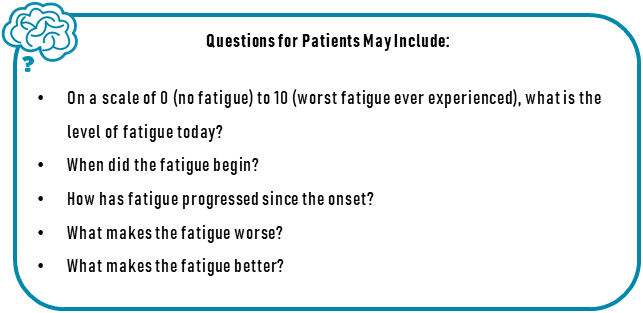
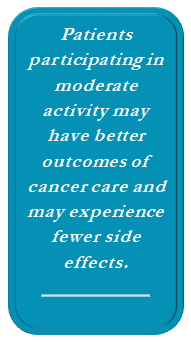 Referencing the symptom journal can help patients identify patterns of peaks in energy levels. These peaks provide an opportunity to accomplish tasks of value. For example, if taking a walk is important, this may be done at times of increased energy during the day. Increasing physical activity may boost energy levels. Sleep disturbance may be alleviated with increased physical activity and limiting caffeine and naps late in the day. Patients participating in moderate activity may have better outcomes of cancer care and may experience fewer side effects. In some cases, psychosocial interventions, nutritional consultation, and cognitive therapy are useful tools to decrease the effects of fatigue. Nutritional assessment and consultation with a dietitian can help ensure that patients are getting the proper balance of nutrients, hydration, and electrolytes. See Chapter 9: Nutrition in the Patient with Lung Cancer
Referencing the symptom journal can help patients identify patterns of peaks in energy levels. These peaks provide an opportunity to accomplish tasks of value. For example, if taking a walk is important, this may be done at times of increased energy during the day. Increasing physical activity may boost energy levels. Sleep disturbance may be alleviated with increased physical activity and limiting caffeine and naps late in the day. Patients participating in moderate activity may have better outcomes of cancer care and may experience fewer side effects. In some cases, psychosocial interventions, nutritional consultation, and cognitive therapy are useful tools to decrease the effects of fatigue. Nutritional assessment and consultation with a dietitian can help ensure that patients are getting the proper balance of nutrients, hydration, and electrolytes. See Chapter 9: Nutrition in the Patient with Lung Cancer
Fatigue symptoms usually decrease, and energy levels improve after treatment has been completed, but some patients experience prolonged fatigue Intervention must begin early in treatment so that fatigue does not affect function, increase distress, and impair the ability to cope with the disease and treatment.
Gastrointestinal (GI) Symptoms Associated with Lung Cancer
Nausea and Vomiting
Chemotherapy-induced nausea and vomiting are often associated with the onset of treatment but are not caused by all chemotherapy agents. Nausea and vomiting can have a major effect on quality of life. Uncontrolled nausea and vomiting will decrease quality of life and may cause nutritional deficiencies, metabolic imbalances, a decline in functional ability, and withdrawal from therapy.12-13 There have been major advances that effectively control and prevent nausea and vomiting. Antiemetic drugs prevent nausea and vomiting and are frequently given to patients receiving chemotherapy.
The healthcare team can estimate the type of symptoms experienced from the class of chemotherapy drug, the dosage of radiation, or surgery. Nausea and vomiting are classified as acute, delayed, anticipatory, breakthrough, and refractory. Acute nausea and vomiting occur within 24 hours after treatment. Delayed nausea and vomiting occur after 24 hours following treatment, typically within 48 to 72 hours after treatment, lasting up to a week, and are likely to occur with chemotherapy agents such as cisplatin and carboplatin. Anticipatory nausea and vomiting, triggered by thoughts of starting a new cycle of treatment, may occur in 20% of patients. Breakthrough nausea and vomiting occur when anti-nausea medications fail, and the healthcare team may increase the dosage or prescribe an alternative antiemetic medication. It is easier to prevent nausea and vomiting from occurring than to control it, so clinicians often prescribe antiemetic medications prior to the start of the treatment cycle. Common antiemetics include ondansetron, palonosetron, dolasetron, prochlorperazine, and promethazine, and drug selection is based on the treatment regimen and side effect profile. These medications come in liquid, tablet, and suppository forms. In some cases, the antiemetic is given concurrently with chemotherapy infusion. Depending on the treatment, the treatment team may recommend that the patient continue taking the medication for several days.
Strategies to Manage Nausea and Vomiting
The risk of developing chemotherapy-induced nausea and vomiting can often be predicted based on the drug regimen, so it is important to communicate the symptoms, if any, prior to the start of each new therapy. It is important to relay any change or breakthrough nausea experienced. If this occurs, there are several different medications that can be prescribed. Antiemetic medication can be prescribed to alleviate anticipatory nausea. In addition, behavioral therapy or systematic desensitization can be successful in decreasing anticipatory nausea. It is important that the patient stay hydrated and have increased fluid intake (small amounts frequently) because dehydration can make symptoms worse. In addition, breathing exercises and relaxation are important ways to alleviate symptoms.
Bowel Changes
Depending on the course of treatment, patients may experience a change in their bowel habits to include both constipation and diarrhea. The most frequently reported symptom in patients on immunotherapy is diarrhea. The incidence of diarrhea is greater on anti-PD-1 and PDL-1 agents.14 Patients also report that diarrhea can occur months after discontinuing an immunotherapy treatment. Monitoring and self-reporting of the frequency of symptoms to the clinical team is critical. They will determine the level of severity and the impact or changes in the treatment regimen.
Constipation can be uncomfortable and accompanied by abdominal discomfort and cramping. It can be caused by physical weakness, changes in appetite, decreased activity, and medications such as pain medications. Constipation may be relieved by relaxation, increased physical activity, and altered diet including an increase in fluids, vegetables, fruits, and fiber. If symptoms persist, discussion with the healthcare team may be helpful. Maintaining a journal of symptoms can provide useful information, including the duration of constipation and alleviating factors, this helps develop a treatment plan. Before taking herbal supplements, laxatives, or stool softeners, the patient should check with the healthcare team to ensure these nonprescription medications will not interact with any treatment medications.
Changes in Weight
Weight loss – may progress during the disease and may be distressing because it can be easily seen. The causes of continued weight loss can include a metabolic reaction to the cancer; difficulty swallowing because of persistent cough, dyspnea, or radiation-induced esophagitis; depression; and side effects of treatment including poor appetite, mouth sores, nausea, vomiting, difficulty swallowing, sore throat, dry mouth, or a change in taste sensation.
The most serious and distressing form of cancer-related weight loss and weakness is cancer cachexia. The patient loses body fat and lean muscle mass. Although weight loss can be a symptom associated with all stages of lung cancer, cancer cachexia is associated with advanced or metastatic lung cancer.
The healthcare team checks a patient’s weight at each follow-up visit, and the patient should also monitor changes in weight. If weight loss is substantial and intervention is needed, an appetite stimulant might be prescribed, such as megestrol, dexamethasone, or prednisone. When the loss of muscle mass has occurred, an anabolic steroid might be prescribed.
It is important to maintain a healthy, balanced diet. With weight loss during treatment, eating foods to “bulk up” may not address muscle loss because high caloric foods may cause weight gained from fat. It is essential that a balanced diet is consumed, rich in vitamins, minerals, proteins, and carbohydrates.
Consulting with a nutritionist or registered dietitian can be helpful in developing a diet that meets the patient’s individualized needs. Earlier determination of the cause of weight loss may provide a better outcome and overall better tolerability. If the weight loss is caused by difficulty in swallowing, nausea, vomiting, or mouth sores, the underlying causes must be addressed. Although patients might not feel like eating, it is important to keep up their energy and strength. Maintaining healthy nutrition while undergoing treatment can help boost the immune system and help the patient better tolerate treatment.
Weight gain – Patients may experience weight gain during treatment because of prescribed medications, such as steroids, including prednisone that may cause increased appetite and weight gain. In addition, some medications may cause fluid retention. Weight gain should be discussed with the healthcare team, and a nutritional consultation may be necessary. See Chapter 9: Nutrition in the Patient with Lung Cancer.
Respiratory Symptoms of Lung Cancer
Cough
Cough is a very common symptom of lung cancer. A persistent cough may be an early symptom that may lead to a lung cancer diagnosis and may be a troubling symptom throughout the disease course, interfering with speech, eating, and sleeping. Coughing is a natural response to irritation of the airways, and it is the body’s way of clearing out the airways to eliminate any foreign substance. A cough may be dry or productive. Dry cough can be caused by allergies, inhalation of irritants, sore throat, asthma, or sinusitis. Productive cough, which is the coughing up of phlegm (mucus), is a result of chest congestion or excess fluid in lungs, and may be caused by the common cold, pneumonia, flu, or bronchitis. It is important to note if the phlegm (mucus) is blood-streaked (hemoptysis). While hemoptysis is common in lung cancer, the frequency and quantity of blood should be communicated to the treatment team to determine its acute or chronic nature.
The development of a cough that interferes with normal activities should be reported. Recognizing and intervening early can help to decrease unnecessary suffering. Tumors can also partially block or completely block airways and could be the primary cause of a cough and infection. If infection occurs, antibiotics may be prescribed, or a procedure may be done to unblock the airways.15 The healthcare team may evaluate symptoms and recommend a cough suppressant to help alleviate symptoms. Although mild nonprescription cough suppressants are available, persistent symptoms that interfere with daily life may be treated with bronchodilators or opiate drugs.
Difficulty Breathing (Dyspnea)
Dyspnea is labored, difficult breathing, often leading to discomfort. It may be felt as fast, shallow breathing, chest tightness or pressure, perceived suffocation, and shortness of breath. Patients may say, “I feel like I cannot catch my breath”. Dyspnea may be associated with other respiratory conditions such as asthma, chronic obstructive pulmonary disorder, or emphysema. Dyspnea may be present at rest and increased during physical exertion. Dyspnea may evoke anxiety that may worsen other symptoms. The monitoring of respiratory symptoms is important for maintaining quality of life.
Causes of dyspnea include infection, accumulation of fluid in or around the lungs (pleural effusion), or recent surgery. It is important to discuss the onset of these symptoms with a member of the healthcare team. The treatments may vary and could include supplemental oxygen or prescribed medications such as steroids or bronchodilators. Evidence based pharmacological management of dyspnea also includes the use of systemic opioids in addition to non-pharmacological interventions to help breathing efficiency and capacity. These techniques include breathing from the diaphragm, positioning, pacing techniques. Research has shown that teaching patients breathing retraining in combination with psychosocial or behavioral interventions to address the associated and related anxiety has been successful.16 If dyspnea is related to a pleural effusion, surgery (pleurodesis) may be an option to remove the excess fluid. Approximately 50% to 70% of patients with pleural effusion experience dyspnea. Recent studies show that pharmacological interventions such as opioids may provide relief for patients. Self-help strategies can be helpful, including controlled breathing, coping skill training, focused abdominal breathing, meditation, and relaxation techniques.
Other Symptoms of Lung Cancer
Skin Conditions
Immunotherapy is one of the latest advances in lung cancer. It is a treatment that is driven by stimulating the body’s immune response, leveraging that response to attack the tumor. These drugs often have adverse effects triggering other immune responses impacting the skin.14-15 A rash is a noticeable change in skin color, texture, and appearance. It may be localized to a part of the body or may affect the entire body. Rashes can cause discomfort and affect appearance and self-esteem. Skin inflammation and rash may be a side effect of some chemotherapy agents, and these rashes can be mild to severe, affecting the face, scalp, neck, and back. The irritation is characterized by redness and may resemble acne, which can be uncomfortable. The healthcare team should be informed of a rash.
Treatment may include antibiotics and topical creams. If symptoms become severe, the chemotherapy drug may be changed or discontinued until symptoms resolve. Self-help strategies to control and manage treatment-related skin irritation include avoiding the sun and ultraviolet light, avoiding hot showers, staying hydrated, and using fragrance-free and sensitive skin products.
Changes in Blood Cell Counts (Anemia and Neutropenia)
Chemotherapy and radiation can cause myelosuppression, which is suppression of the bone marrow, resulting in low blood cell count levels. Red blood cells carry oxygen throughout the body.
Anemia (low red blood cell count) may occur as a result of cancer or chemotherapy, resulting in fatigue and weakness. After evaluation to determine the cause of the anemia, patients may be prescribed medications, such as epoetin or darbepoetin, or a transfusion of packed red blood cells.
White blood cells help to fight infection,15 and neutropenia (low white blood cell count) is a risk factor for the development of infection in cancer patients. Fever is an early sign of infection, and it is important to report any elevated body temperature. Elevated temperature (> 100ºF) could indicate infection and should be monitored closely. Additional signs of infection include chills, pain, swelling, redness at an incision site, mouth sores, and diarrhea. If patients experience any of these symptoms, they should immediately contact their treatment team. In many cases, antibiotics may be prescribed. It is especially important to report any fever or other symptoms when patients are participating in clinical research trials.
Effective strategies to prevent and manage infections in neutropenic cancer patients have led to better outcomes. Medications that may prevent blood counts from dropping include filgrastim and pegfilgrastim.
Cancer-Related Pain
Pain is a frequent and distressing symptom associated with lung cancer, and the management of cancer-related pain can be complex. Pain is the most common cause of disability and associated with sleep disturbances, anxiety, and dyspnea, all impacting quality of life when not controlled.17 Pain is often associated with emotional distress in cancer patients. The patient may experience pain as a result of cancer pressure on a nerve, spread to the bone, or treatment. Pain is subjective, and pain tolerance varies.
The National Comprehensive Cancer Network (NCCN) defines cancer pain as a sensory and emotional response associated with actual or potential tissue damage. Reporting pain early and referral to supportive cancer services are crucial for the management of any pain. Pain is experienced in more than half of patients undergoing treatment, 65% of patients with advanced-stage disease, and in about a third of patients after curative treatment.18-20
In most patients, cancer pain can be controlled with prescribed medication and behavioral strategies. However, unrelieved pain may have a major negative effect on the quality of life, and pain can inhibit normal activities. Chronic pain robs patients of comfort and affects motivation, social interactions, and activities.
Early treatment of pain is preferred. A comprehensive assessment may provide a detailed description to ensure effective management. Pain levels are self-reported, and analog scales are used by clinicians.

The pain scale is an effective way to describe the magnitude of pain experienced (mild, 1 to 3; moderate, 4 to 7; severe, 8 to 10).18 There also are non-verbal cues, such as body language and facial expressions, that family members can use to be aware of the pain level experienced by a patient. Treatment can be tailored and individualized. Medications can cause new side effects or can make existing side effects worse, so the goal is to minimize the pain experienced and limit the potential side effects of pain medications. It is important to discuss expectations and goals associated with symptom management openly.
Neuropathic pain is a chronic, often debilitating, condition affecting many cancer patients. Signs and symptoms can vary from patient to patient. Cancer patients experience neuropathic pain as a result of nerve compression by the tumor or neurotoxicity of chemotherapy agents.21
Chemotherapy-induced peripheral neuropathy is a subset of neuropathic cancer syndromes. When chemotherapy-induced peripheral neuropathy is present, treatment is stopped, and time is allowed for nerves to recover. Stopping anti-tumor treatment is a difficult decision. Patients and providers must weigh the potential benefits of treatment against the devastating short- and long-term impairment. Neuropathy can be a major cause of symptom distress. It can produce high levels of pain, numbness, burning sensations, discomfort, sensorimotor dysfunction, and interference with daily activities.
Strategies for Pain Management
After a thorough evaluation, interventions can help decrease pain. The goals of pain management are to optimize the effects and tolerability of treatment. These goals are referred to as the 5 A’s and include: Analgesia (pain relief), Activities (optimizing the ability to carry out daily activities), Affect (improve relationship between pain level and mood), Adverse Effects (reduce) and Aberrant drug use (avoid addiction).18 Relieving medications (analgesics) include non-opioids such as naproxen, ibuprofen, aspirin, nonsteroidal anti-inflammatory drugs (NSAID), and acetaminophen. Acetaminophen is an analgesic and antipyretic but not an anti-inflammatory drug and may be cautioned for those with compromised liver and kidney function. These medications are suggested for mild pain. Opioids frequently are prescribed for moderate pain, and these include hydrocodone, codeine, oxycodone, propoxyphene, or tramadol. If pain is severe, stronger opioids are prescribed, such as morphine, oxycontin, or fentanyl. Pain medications come in varied forms and delivery systems (tablets, liquid, transdermal patches, suppositories, and injections). For patients with difficulty swallowing, a liquid may be prescribed. In addition, pain pumps and devices can be implanted to provide continuous delivery of medication.
Opioids can cause new side effects or can make existing side effects worse. Opioids cause constipation, nausea, and skin itchiness (pruritus). Pruritus occurs in 10% to 50% of patients taking opioids.23-25 Some symptoms can be anticipated, and measures can be taken for prevention. Opioid-induced constipation can be treated with stool softeners or dietary changes and increased fluid intake. Severe pain may be relieved with interventional therapies, including nerve blocks or an injection between vertebrae.21-22 It is important to report side effects promptly to the healthcare team. Maintaining information in the symptom journal about pain provides important information that the treatment team can use to help relieve pain.
Self-Help Strategies and Behavioral Interventions
Complementary and alternative medicine strategies or integrative techniques can be used to help alleviate cancer-related pain, including meditation, yoga, acupuncture, and massage. Many patients do not report all levels of pain experienced because they feel that pain is a normal effect of cancer, they fear becoming addicted to pain medication, or they fear side effects. For those who have concerns about medication, these techniques can be powerful because they focus on the mind-body relationship and help the body relax, which has benefits far beyond pain control.
Pain can be controlled by cognitive techniques such as guided imagery (for example, in a state of relaxation, think about a positive image that evokes a sense of calm, such as a walk on the beach), hypnosis, distraction, or behavioral techniques such as activity pacing, behavioral goal setting, and relaxation. Biofeedback may cause voluntary relaxation of muscles. The benefits of massage include reduction in pain, anxiety, fatigue, and nausea.23 See Chapter 11: Integrative Medicine, Complementary Therapies, and Chinese Medicine in Lung Cancer for more information.
Psychological Symptoms Associated with Lung Cancer
The diagnosis of lung cancer is a stressful and life-changing event for the patient and entire family, with psychological, social, and emotional challenges. Patients describe having to find a new sense of “normal” because the disease has such far-reaching effects on all aspects of daily life. This life-threatening illness can have severe effects on psychological health.
The stress associated with cancer can manifest physically and psychologically. Although the psychological changes may be more difficult to recognize, they are just as important and should be addressed. It is very common to have emotional and psychological distress in cancer patients. It may occur immediately after diagnosis and throughout treatment and may worsen as the condition deteriorates.3 Many of the drugs used in cancer treatment can affect the balance of chemicals in the brain and contribute to changes in behavior, mood, sleep patterns, and anxiety levels.
Psychological distress may cause a lack of motivation to engage in meaningful activities, a reduction in cognitive and social functioning, and an overall increased level of fatigue. It is important that an open discussion occurs with the healthcare team about all aspects of the treatment, and activities that are meaningful to the patient are identified. If treatment and side effects prevent the patient from engaging in these activities, psychological distress levels and coping ability can be drastically affected. Depression is especially common in lung cancer patients, and those receiving a lung cancer diagnosis may experience higher levels of distress compared with other cancer diagnoses, in part because of the advanced-stage of cancer at diagnosis and the heavy burden of symptoms frequently associated with lung cancer.26
Functional impairment, which is the inability to carry out functional activities, is the most important risk factor for the development of depression. For every increment of physical impairment, the risk of depression is increased by 41% because the patient can no longer perform the same level of activities as before diagnosis or treatment.24 Patients must rely on others, and this loss of independence can lead to distress and depression.
A cancer diagnosis generates feelings of sadness, anger, anxiety, and fear. Patients and families struggle with quickly having to define, put into context, comprehend, and make important decisions. The initial adaptation to a diagnosis can be influenced by pre-existing psychological factors.25-27 Patients who have a history of depressive disorders (diagnosed or undiagnosed) should be carefully monitored throughout the cancer course because the events associated with the diagnosis serve as triggers for depression. A history of depressive disorders can be worsened or aggravated by the cancer course. People deal with their diagnosis in the context of their social environment, and the social support system can positively or negatively influence how a patient copes with the illness.
A cancer diagnosis and treatment may cause cognitive changes. “Chemo-brain” is a term often used to describe a group of symptoms related to the effects of cancer treatment. Symptoms include levels of forgetfulness, difficulty concentrating, and difficulty with multitasking. This can become a very distressing and a lingering symptom.
There may be unmet psychological burdens experienced in tobacco-related disease, including elements of blame or guilt that patients place on themselves. This can severely affect coping ability and the seeking of supportive services. Early assessment and treatment of these symptoms are crucial for maintaining quality of life. There are treatments and strategies that can help patients better cope throughout the cancer course.
Distress
The overall psychological burden of the cancer experience is referred to as distress. Distress is a multi-factorial emotional, psychological, social, and spiritual experience that can interfere with the ability to cope with a cancer diagnosis and treatment.28 The prevalence of distress varies by cancer type and ranges from 35% to 43% in lung cancer.25 There are many symptoms of cancer-related distress. Patients can feel general denial, sadness, anger, fear, or vulnerability. These feelings are normal responses to coping with the disease. This generalized distress can progress to more severe depression and anxiety and cause an inability to cope with daily life.
Distress can affect quality of life during the entire course of the illness. Many (25% to 40%) of cancer survivors continue to suffer from sadness, often severe enough to require intervention.26 The end of treatment can also be a time of heightened distress because there is uncertainty about cancer recurrence. Furthermore, responsibilities that are often placed on hold during treatment must now be addressed. In addition, the patient may face the loss of a strong support system because of decreased contact with members of the treatment team, family, or friends.
Psychological issues often are unreported for many reasons, including the general stigma about psychological issues or feeling that symptoms are expected. Although there are varied levels of distress, mild symptoms may affect normal daily activities, and this should be discussed with the healthcare team. Mild distress includes fear, uncertainty, worry, sadness, poor sleep, poor concentration, or thinking too much about the illness. Mild distress can become severe, so it is important to evaluate distress levels frequently, identify distress early, and intervene. Early evaluation and screening can lead to timely management of distress and minimize interference with daily activities. Distress may be unrecognized, and only 10% of patients receive support for distress.26
Assessment and Strategies for Self-Help
The National Comprehensive Cancer Network (NCCN) recommends screening all cancer patients for psychological distress at each follow-up visit.28-30 The Distress Thermometer is a standardized survey frequently used to measure and evaluate distress. The Distress Thermometer quantifies stress on a scale from 0 to 10 (0, no distress; 10, extreme distress), based on the answer to the question, “How is your level of distress today?” or “How is your level of distress been during the past week?” The Distress Thermometer may be accompanied by a 38-item problem list, which may identify problems in five different categories: practical, family, emotional, physical, and spiritual or religious. Greater distress is associated with negative outcomes, including non-adherence to treatment recommendations, poor satisfaction with overall care, and decreased quality of life.30-31
The healthcare team may include professionals who are experts in psycho-oncology, including social workers, chaplains, palliative care specialists, psychologists, and psychiatrists. Experts in this field can assess and provide critical support for patients and their families. A patient’s coping style and perceived social support are two important factors positively associated with adaption to distress.
Social support, community resources, and support groups may be helpful, including peer support calls, telehealth/virtual connections, personal counseling, and group meetings. The choice of resources is based on comfort level of the patient and availability of community resources, including individuals who have experience. Expressing emotions may help the patient and family cope with the disease.
Each individual may cope differently with each situation, frequently within the context of the individual’s social structure. A strong support system can ensure patients feel comfortable openly discussing symptoms and may help in recognition of new or abnormal symptoms.
Anxiety
Anxiety is a normal response to a diagnosis of cancer, but it often is inadequately treated, can impede daily functioning, and can have a substantial negative effect on quality of life. Anxiety can manifest as physical symptoms such as gastrointestinal disturbances, restlessness, sweats, palpitations, dyspnea, and panic attacks. It also can manifest as behavioral symptoms such as feelings of uneasiness, restlessness, loss of concentration, excessive intrusive thoughts, and seeking continual reassurance or comfort from outside.32 Some anxiety is normal, but persistent anxiety that disrupts daily functioning is termed maladaptive anxiety and requires intervention.
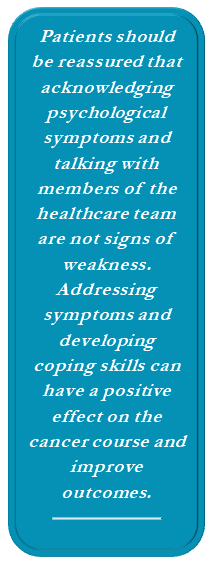 Anxiety can occur at any time in a patient’s cancer course, including the time of diagnosis, treatment, and survivorship, when anxiety may develop about the possibility of recurrent cancer.30 The healthcare team can assess symptoms and determine the primary causes of the anxiety. Anti-anxiety medication and antidepressants may be prescribed.
Anxiety can occur at any time in a patient’s cancer course, including the time of diagnosis, treatment, and survivorship, when anxiety may develop about the possibility of recurrent cancer.30 The healthcare team can assess symptoms and determine the primary causes of the anxiety. Anti-anxiety medication and antidepressants may be prescribed.
Depression
Depression may include sadness, lack of interest in normal activities, fatigue, and low energy. Reactive depressive symptoms, including denial and anger, may be a normal reaction to a stressful and unexpected event. These symptoms become problematic when they interfere with normal life and daily living. Depression is often under-reported and undertreated. This may be attributable to the perceived stigma associated with the disease. The National Comprehensive Cancer Network (NCCN) reports the following symptoms associated with depression: low mood, difficulty concentrating and remembering, irritability, loss of sexual interest, changes in emotions, loss of interest in social activities, changes in sleep, loss of energy and motivation, fatigue, anxiety, feelings of hopelessness, frequent or excessive worry, panic attacks, physical symptoms such as upset stomach, and increased interest in alcohol or addictive substances.33
There are antidepressant drugs, anti-anxiety medications, and self-help techniques that can help a patient cope. Cognitive behavioral therapies, relaxation, and improving problem solving skills may be useful. Cognitive behavioral therapy may improve coping and decrease psychological symptoms.34 Patients should be reassured that acknowledging psychological symptoms and talking with members of the healthcare team are not signs of weakness. Addressing symptoms and developing coping skills can have a positive effect on the cancer course and improve outcomes.
Conclusion
There are many side effects associated with a lung cancer diagnosis and treatment. These symptoms can negatively affect a patient’s well-being and quality of life. It is important to prepare for, identify, and recognize symptoms early and communicate about symptoms to decrease any unnecessary suffering or interruption in the course of treatment.
Supportive care is valuable to patients and families who must cope with lung cancer. Patients play an important role in understanding and profiling the symptoms associated with newer classes of therapies. Communication with the treatment team can help prevent and manage symptoms and help future patients by creating a side effect profile for each specific treatment. Clinicians continue to gain a better understanding of the prevalence of specific symptoms and are developing effective strategies and early detection tools to manage lung cancer symptoms better.

References
- Malin JL, O’Neill SM, Asch SM, et al. Quality of supportive care for patients with advanced cancer in a VA medical center. J Palliat Med. 2011;14(5):573-7.
- Shinde, A, Dashti, A. Palliative care in Lung Cancer. Cancer Treatment Res. 2016; 170-225-50.
- Fitch MI, Steele R. Supportive care needs of individuals with lung cancer. Can Oncol Nurs J. 2010;20(1):15-22.
- Olver I, Keefe D, Herrstedt J, Warr D, Rolia F, Ripamonti C. Supportive Care in Cancer-a MASCC perspective. Support Care Cancer. 2020 Aug; 28(8):3467-75.
- Boehmer L, Waqar S, Butler S, et al. Summary of presentations from the 46th annual meeting of the American Society of Clinical Oncology (2010): focus on supportive care issues related to lung cancer. J Thorac Oncol. 2011;6(3):645-9.
- Sanders SL, Bantum EO, Owen JE, et al. Supportive care needs in patients with lung cancer. Psychooncology 2010;19(5):480-9.
- Temel JS, Greer JA, Muzikansky A, et al. Early palliative care for patients with metastatic non-small-cell lung cancer. N Engl J Med. 2010;363(8):733-42.
- Dahlin CM, Kelley JM, Jackson VA, et al. Early palliative care for lung cancer: improving quality of life and increasing survival. Int J Palliat Nurs. 2010;16(9):420-3.
- Berger AM, Mooney K, Alvarez-Perez A, et al. Cancer-Related Fatigue, Version 2.2015. J Natl Compr Canc Netw. 2015;13(8):1012–1039. doi:10.6004/jnccn.2015.0122
- Shun SC, Lai YH, Hsiao FH. Patient-related barriers to fatigue communication in cancer patients receiving active treatment. 2009;14(9):936-43.
- Recovery issues in cancer survivorship: a new challenge for supportive care. Alfano CM, Rowland JH. Cancer J. 2006 Sep-Oct;12(5):432-43. Review.
- Islam KM, Anggondowati T, Deviany P et al. Patient preferences of chemotherapy treatment options and tolerance of chemotherapy side effects in advanced stage lung cancer. BMC Cancer. 2019 Aug 27; 19(1): 835.
- Check DK, Basch EM. Appropriate Use of Antiemetics to Prevent Chemotherapy-Induced Nausea and Vomiting. JAMA Oncol. 2017;3(3):307–309. doi:10.1001/jamaoncol.2016.2616
- Puzanoz L, Diab A, Abdallah K, et al. Managing toxicities associated with immune checkpoint inhibitors: consensus recommendations from the Society for Immunotherapy of Cancer (SITC) Toxicity Management Working Group. J Immunother Cancer. 2017; 5:95.
- Segal BH, Freifeld AG, Baden LR, et al. Prevention and treatment of cancer-related infections. J Natl Compr Canc Netw. 2008;6(2)122-74.
- Yates, P, Hardy, J., Clavarino, A. Fong, K, Mitchell, G, et al. A Randomized Controlled Trial of a Non-pharmacological Intervention for Cancer-Related Dyspnea Front Onc 2020, Dec; 10:561610
- PDQ Supportive and Palliative Care Editorial Board. Cancer Pain (PDQ®): Health Professional Version. PDQ Cancer Information Summaries [Internet]. Bethesda (MD): National Cancer Institute (US); 2002–2016.)
- Swarm RA, Abernethy AP, Anghelescu DL, et al. Adult cancer pain. J Natl Compr Canc Netw. 2013;11(8):992–1022. doi:10.6004/jnccn.2013.0119
- Kapo JM, Akgun KM. Integrating Palliative Care Into the Care of Patients with Advanced Lung Cancer. Cancer J. 2015 Sept-Oct; 21(5):434-9
- Aragon KN. Palliative Care in Lung Cancer. Clin Chest Med 2020 Jun; 41(2): 281-293.
- Paras-Bravo, P, Paz-Zulueta M, Alonso-Bianco M, Etal. Association among presence of cancer pain inadequate pain control, and psychotrophic drug use. PLOS One. 2017; 12(6): e0178742.
- Cleeland CS, Farrar JT, Hausheer FH. Assessment of cancer-related neuropathy and neuropathic pain. Oncologist 2010;15 (Suppl 2):13-8.
- Cassileth BR, Keefe FJ. Integrative and behavioral approaches to the treatment of cancer-related neuropathic pain. Oncologist 2010;15 (Suppl 2):19-23.
- Levy MH, Back A, Benedetti C, et al. NCCN clinical practice guidelines in oncology: palliative care. J Natl Compr Canc Netw. 2009;7(4):436-73.
- Green CR, Hart-Johnson T, Loeffler DR. Cancer-related chronic pain: examining quality of life in diverse cancer survivors. Cancer. 2011 May 1;117(9):1994-2003. doi: 10.1002/cncr.25761. Epub 2010 Nov 18.
- Zabora J, Brintzenhofe Szoc K, Curbow B, et al. The prevalence of psychological distress by cancer site. Psychooncology 2001;10(1):19-28.
- Hopwood P, Stephens RJ. Depression in patients with lung cancer: prevalence and risk factors derived from quality-of-life data. J Clin Oncol. 2000;18(4):893-903.
- Holland JC, Andersen B, Breitbart WS, Buchmann LO, Compas B, Deshields TL, et al. Distress Management. Journal National Comprehensive Cancer Network. 2013;11(2):190–209.
- Tuinman MA, Gazendam-Donofrio SM, Hoekstra-Weebers JE. Screening and referral for psychosocial distress in oncologic practice: use of the Distress Thermometer. Cancer 2008;113(4):870-8.
- Jacobsen PB, Donovan KA, Trask PC, et al. Screening for psychologic distress in ambulatory cancer patients. Cancer. 2005;103(7):1494-502.
- Sarna L, Padilla G, Holmes C, Tashkin D, Brecht ML, Evangelista L. Quality of life of long-term survivors of non-small-cell lung cancer. J Clin Oncol. 2002 Jul 1;20(13):2920-9. PMID:12089220
- Buchanan D, Milroy R, Baker L, Thompson M, Levack P. Perceptions of anxiety in lung cancer patients and their support network. Supportive Care in Cancer 2009;18(1):29-36.
- Voogt E, van der Heide A, van Leeuwen AF, et al. Positive and negative affect after diagnosis of advanced cancer. Psychooncology 2005;14(4):262-73.
- Gonzalez BD1, Jacobsen PB, Depression in lung cancer patients” the role of perceived stigma. 2012 Mar;21(3):239-46. doi: 10.1002/pon.1882

